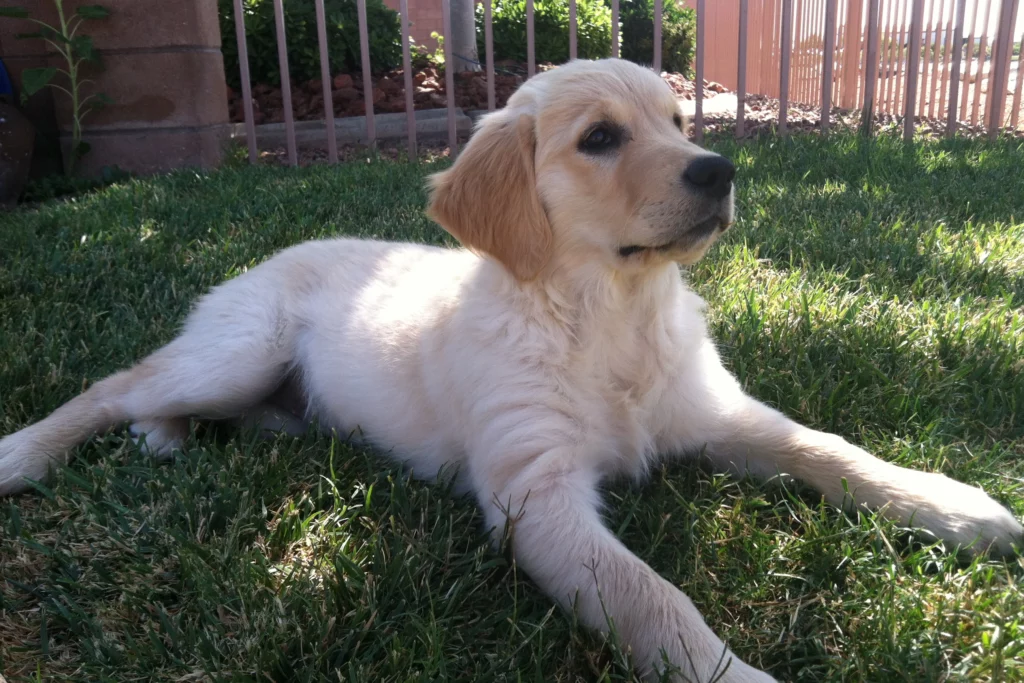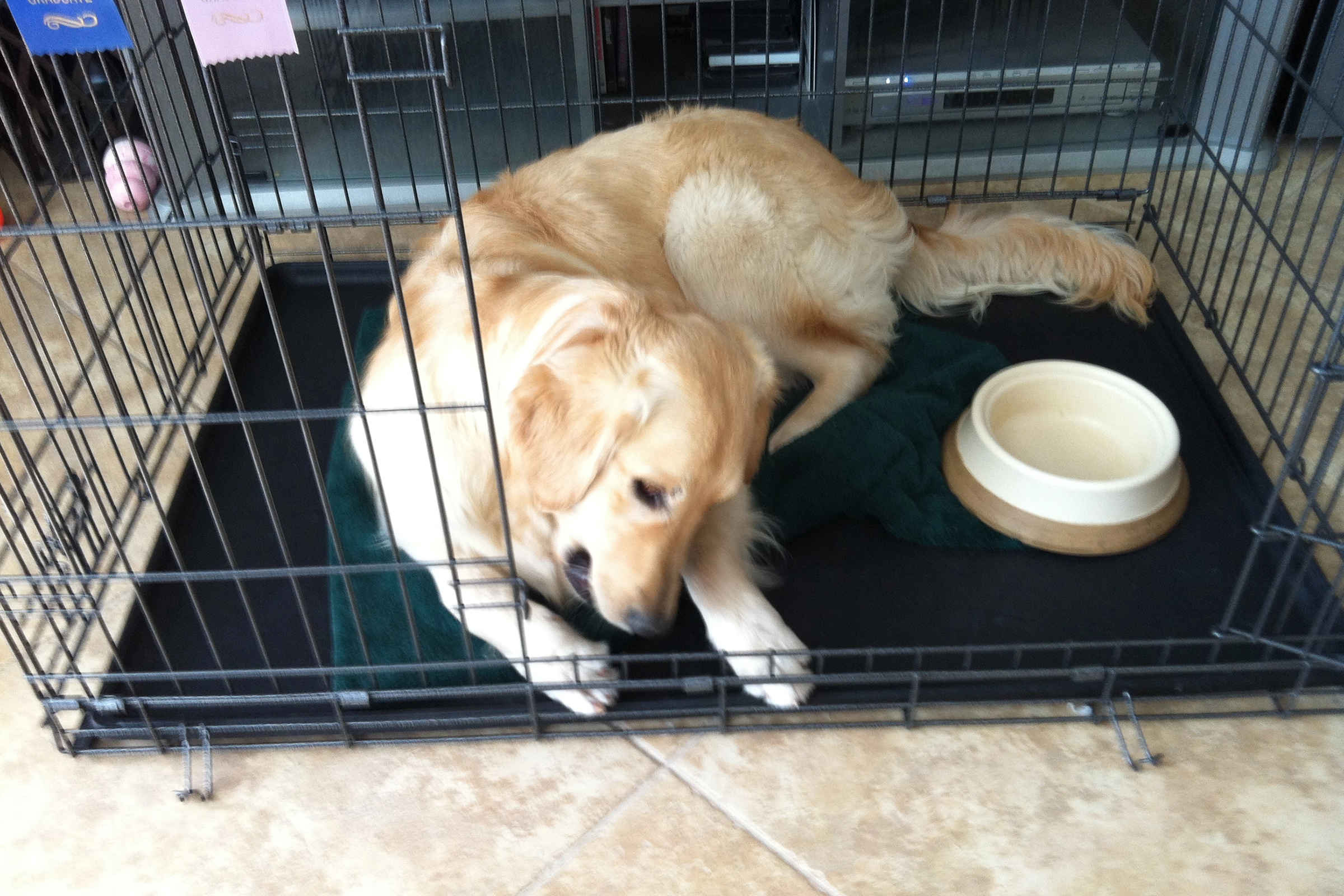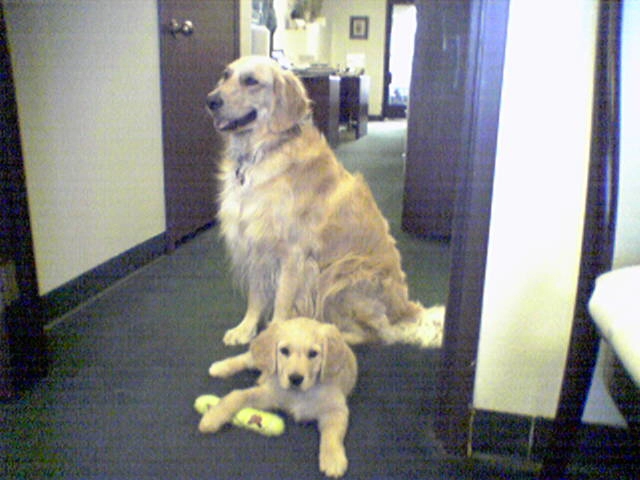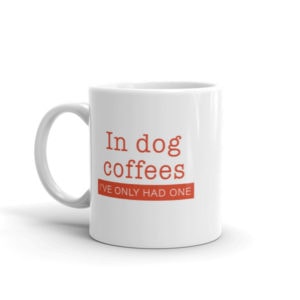This post may contain ads and affiliate links and we may earn a small commission when you click on the links at no additional cost to you. As an Amazon Affiliate, we earn from qualifying purchases. You can read our full disclaimer here.
Golden Retriever Puppy Color Change: An Unfolding Palette

Have you ever noticed a Golden Retriever puppy color change as they mature into adults? It’s a delightful part of being a pet parent to these friendly and intelligent dogs.
Golden Retrievers are famous for their lush, golden coats, but did you know their color can vary significantly from puppyhood to adulthood? That’s right – the adorable golden bundle you bring home could look quite different a year later.
Understanding Golden Retriever Puppy Color Changes
Golden Retriever puppies are often born with light coats that gradually darken over time. Some may start as cream-colored furballs, while others might be a light gold.
But don’t get too attached to your puppy’s initial color. This color is likely to shift over the first few years of their life.
From Light to Gold
As your Golden Retriever grows, you might start to notice changes in their coat color. Usually, this transition begins around the age of six months and continues till they’re about three years old. By that time, their adult coat has fully come in.



Why the Color Change?
Well, it’s all part of their natural development. As they mature, their coats can change from light cream to dark gold. But why exactly does this happen? There are a couple of reasons.
Genetics and Environment: A Dynamic Duo
- Genetics: Much like our hair color, the color of a Golden Retriever’s coat is determined by their genes. Different genes influence the intensity and type of pigmentation, which gives us the wide spectrum of golden shades we see in these dogs.
- Environment: Factors such as sunlight and season can also affect your Golden Retriever’s coat color. Yes, just like humans can get sun-kissed hair in the summer, your Golden’s coat can lighten or darken based on their exposure to sunlight.
Don’t miss our post about Golden Retriever feathers!
Personal Experiences of Golden Retriever Puppy Color Change: Meet Daisy, Lucky, and Penny
Let me introduce you to my beloved Golden Retrievers: Daisy, Lucky, and Penny. Their individual color journeys have offered me rich insights into the incredible world of Golden Retriever puppy color change.
Daisy: The Cream to Gold Journey
First, meet Daisy. Daisy was a light cream puppy, like a dollop of whipped cream on a hot summer day. As she matured, she blossomed into a light gold, her coat retaining hints of her cream beginnings.
Lucky: The Gold That Deepened
Next up is Lucky. Lucky entered our lives as a pale gold puppy, reminding us of a soft morning sunrise. As he grew, his coat deepened to a richer, darker gold, perfectly living up to his Golden Retriever name.
Penny: The Golden Evolution
Finally, there’s Penny. Penny was a slightly lighter gold puppy, with her coat reminding me of freshly spun honey. As she matured, her coat evolved into a more pure gold, giving her a radiantly warm and regal appearance.


Deep Dive: The Genetics of Color Change
Genes: The Color Masters
The color change journey of a Golden Retriever is largely guided by their genetics. A puppy’s genes, inherited from its parents, determine the potential range and intensity of coat colors.
The Shades of Gold
Golden Retrievers come in a variety of shades, from a light cream to a rich, dark gold. This spectrum is created by different combinations of color genes.
Genes at Play
There are two primary genes at play:
- Extension gene (E): This gene controls whether a dog will have black (E) or yellow to red (e) in their coat. Since Golden Retrievers are always ee, they will always fall within the yellow to red spectrum.
- Intensity locus (I): This gene influences how intense or dilute the red to yellow pigmentation will be. The II dogs will have more intense coloring, while ii dogs will have lighter, more cream colors.
Golden’s Golden Rule
It’s essential to understand that a Golden Retriever’s puppy color doesn’t always indicate their final adult color. For instance, a light-colored puppy may darken, and a darker puppy might lighten.
The final adult color can take up to three years to fully develop.
The Golden Spectrum: Exploring Different Types of Golden Retrievers
Hunting Goldens: The Active Gold
Firstly, we have the Hunting Golden Retrievers. These dogs are often bred for fieldwork, making them more athletic and agile compared to their counterparts. Their coats are generally darker and richer, ranging from a medium to a dark gold.
English Goldens: The Creamy Elegance
Next are the English Goldens, often referred to as English Cream Golden Retrievers due to their light-colored coats. These dogs often sport a beautiful cream coat that sometimes transitions to a light gold as they age.
Despite the distinct coloring, it’s important to note that “English Cream” is just a color variant and not a separate breed.
Regular Goldens: The Classic Charm
Finally, we have the regular Golden Retrievers. These dogs typically have a medium gold coat, but there’s quite a bit of variation within this group. Their color can range from a light cream to a dark, almost coppery gold.
Regardless of the type of Golden Retriever, it’s always a treat to watch their color transformation from puppyhood to adulthood.
The Process of Golden Retriever Puppy Color Change: A Golden Journey
The First Shift
The color change process in Golden Retrievers is a gradual one. It typically starts when they’re around a year old. One of the first signs of color change can often be seen around their ears. The fur here can start to darken before the rest of the coat follows suit.
Coat Transformation: Step by Step
Here’s a typical sequence of color change in a Golden Retriever:
- Ears: As mentioned, the fur on the ears often darkens first. This gives us a sneak peek of the mature color to come.
- Back and Tail: After the ears, you might notice a change along the back and on the tail. These areas usually follow the pattern set by the ears, gradually darkening in color.
- Chest and Belly: The fur on the chest and belly is usually the last to change. These areas often remain lighter compared to the rest of the coat, creating a beautiful contrast.
The Ear Theory of Golden Retriever Puppy Color Change
You may have heard a popular theory among Golden Retriever enthusiasts – a puppy’s final color will be the color of their ears. This theory holds true often enough to be considered a helpful guide, but it’s not a guarantee.
According to the theory, looking at the color of a puppy’s ears can give you an idea of what color they might turn out to be when they’re grown up. But remember, the genetics of coat color can be complex and surprising!
Seeing your Golden Retriever transform as they grow is one of the many joys of having these dogs as pets.
Wrapping Up Golden Retriever Puppy Color Change
We’ve taken a fascinating journey together, exploring the world of Golden Retriever puppy color change. From understanding why these changes occur, to meeting my own beloved Goldens Daisy, Lucky, and Penny, and appreciating their unique color transformations, we’ve covered a lot of ground.
Remember, whether your Golden is a light cream, a rich copper, or anything in between, each color stage is a beautiful representation of their growth and development. Embrace each phase, just as you do with every wag of their tail and every playful bark.
Your Golden Retriever’s changing coat color is just another reason to love them more each day. So, keep a keen eye on your furry friend as they mature.
You’re not just witnessing a color change, but a unique journey of growth and transformation.
-

Coffee Mug – In Dog Coffees I’ve Only Had One
Price range: $11.95 through $14.95 Select options This product has multiple variants. The options may be chosen on the product page
